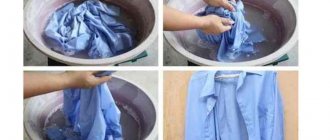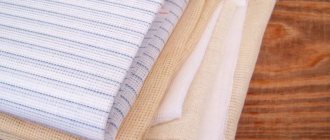Satin is an elite natural fabric with a smooth sliding surface, luxurious shine and impeccable appearance. Initially, only silk fibers were used to create such material, so the products were quite expensive.
Today, a mixture of silk threads with cotton, polyester, viscose or nylon is in great demand. Mixed fabric is cheaper, but still looks elegant and sophisticated.
General washing recommendations
Initially, you need to find the manufacturer’s tags on the product and read its care recommendations. You should not deviate from the recommendations unless absolutely necessary, as this may cause damage to the fabric on the product.
For satin fabrics, hand washing is preferable, since this material is delicate and does not tolerate aggressive influences and active friction, especially its thin representatives for linen and bedding.
It is usually recommended to simply refresh the product in warm water, the heating of which does not exceed 30-40°C degrees Celsius. It is necessary to strictly adhere to the temperature regime and not exceed it. The item requiring washing is pre-soaked in water in which the detergent was previously dissolved for a period of up to five minutes. Afterwards, the foam is carefully squeezed out, and the product requires thorough rinsing in cool water. Wringing, twisting and strong compression of satin fabric is prohibited due to the possibility of loss of shape and the appearance of creases in the fabric.
If it is not possible to wash by hand, you can use a washing machine:
- In this case, it is necessary to turn on the most gentle delicate mode for thin fabrics, and also wash at a temperature not exceeding 40°C degrees Celsius, and spinning and machine drying should be completely abandoned. This can cause unpleasant creases in the fabric and lead to loss of quality of the material.
- As detergents, it is necessary to use only liquid or gel-like substances without aggressive components, suitable for delicate washing. An ideal option would be special detergents for washing silk items. Regular granular powders do not do the job well and can leave unpleasant streaks and streaks on the fabric after drying, and the use of bleaches can create a yellow tint on satin fabric. It is not at all advisable to use them.
- Rinsing a satin product should be gentle and as abundant as possible. To preserve the color and give the product even more shine, there are recommendations to pour a small amount of table vinegar into the last rinse water.
Pleasant to the body and very cute tunic
Important! Experts do not recommend washing satin pillows, bed linen and satin curtains at home. It is better to trust the professionals and take such items to dry cleaning.
How to iron a dress made of eco-leather
Faux leather looks almost like real leather, but ironing a dress made from this material is even more difficult! The thing is that a layer of polymer, similar to rubber or caoutchouc, is essentially applied to the textile lining, and it is much more difficult to remove creases on it.
- Try to prevent the formation of creases on eco-leather: such products should only be hand washed, dried in a fully extended position, and stored without folding.
- If a crease has formed, know: not a couple of days on a hanger, nor moisture, nor steam will be able to help you.
- There is only one way out - to heat it up. But here you need to act very carefully: the crease can be straightened only under the influence of temperature, but if you overdo it, the leatherette will begin to melt and the dress will be ruined. That is why it is recommended to iron only from the inside out and only at the minimum temperature.
As for steaming, it can help, but only due to the high temperature of the steam, so using ironing to remove creases will be safer and more accurate.
We recommend: Why iron on foil - secrets for those who don’t like to iron things for a long time
What kind of fabric is satin?
Atlas
(Arabic, literally - smooth) - dense silk or semi-silk
fabric
of satin weave with a smooth shiny front surface. With satin weave, the weft comes out to the front surface through five or more warp threads.
Interesting materials:
What to do with a bird with a broken wing? What to do with Poinsettia after flowering? What to do with plants in winter? What to do with remontant blackberries in the fall? What to do with remontant strawberries in August? What to do with remontant strawberries for the winter? What to do with Rhododendron for the winter? What to do with Rhododendron in the fall? What to do with Rhododendron in spring? What to do with roses if they lower their heads?
How to remove stains and shine
- Stains and shiny areas are removed before the main wash. After the procedures, the products are thoroughly rinsed and washed using the method recommended above;
- A fresh stain can be removed with plain water using a soft cloth. Gently blot the contaminated area without rubbing, otherwise dirt or grease will be further absorbed into the fibers of the material;
- Grease stains are first wiped with a damp cloth, then covered with corn or wheat flour and left for an hour. After this, the remaining powder is cleaned off with a soft bristle brush;
- Shiny stains and iron marks are effectively removed by vinegar 9%. To do this, saturate gauze with the product, wring it out and place it on the problem area. Then steam the area, lightly touching the sole of the iron. This procedure will return the presentable appearance of the material.
How to wash satin
Satin is recommended to be washed by hand only. To do this, use slightly warm water with a temperature of up to 40 degrees and a light detergent for delicate fabrics. Shampoo or silk cleaning gel is excellent.
First, soak the items in soapy water for 5-10 minutes, then rinse without much rubbing or squeezing. After this, the items are rinsed several times in cool water until the soap is completely washed away.
Satin items should not be rubbed too hard, squeezed, wrung out, or twisted! This will lead to a deterioration in the quality of the material, the formation of strong folds and creases, which are very difficult to get rid of. You cannot use regular granular powders for washing as they leave yellow marks and stains.
If the label allows it, you can wash satin items in the washing machine. To do this, choose a delicate mode with a temperature of up to 40 degrees and strictly without spinning. For washing, it is better to use mild liquid detergents for silk items or delicate fabrics. These can be various gels, liquid powders and shampoos.
After hand or machine washing, it is important to rinse the fabric thoroughly in a large volume of cool water so that no soap streaks or marks remain. To maintain the shine of the products, add a little vinegar to the water during the final rinse. And to give the fabric softness, add fabric softener.
How to iron a silk dress
Silk seems to be a very delicate material, but in fact it is even easier to iron than synthetics. If, of course, you follow all the rules and recommendations.
- Iron silk items from the wrong side through a layer of gauze or cotton to protect the fabric.
- Do not use high temperatures when ironing silk: you can iron a dress efficiently at a minimum heat level.
- Silk will smooth out better if you start ironing it while still a little damp.
- You can also steam silk, but to prevent hot steam from damaging the dress, it is better to cover it with gauze, and do not bring the steamer itself closer than 7-8 cm.
What if the silk is still artificial? As with other synthetic duplicators of natural fabrics, there is one rule: minimum temperature, ironing from the inside out and certainly a gauze or cotton lining.
Additional ironing methods
There are circumstances when ironing a dress in the traditional way is impossible. Then the following tricks can come to the rescue.
- Hold the dress over a pan of boiling water, avoiding the fabric coming into contact with the gas flame.
- Dry the wet dress with a hot hair dryer.
- Hang the dress on a hanger and run hot water from the shower. Without squeezing, let dry naturally.
- In a house where there is a bathhouse, hang the dress in the steam room - it will straighten out.
How to straighten silk?
A real salvation in this situation is a solution of a tablespoon of glycerin diluted in 5 liters of distilled water. In the resulting solution, the damaged item is moistened and dried. Only after this can it be carefully ironed again.
Interesting materials:
What kind of tissue is in the suction zone? What tragedy happened on March 14? Which pipe is cheaper, profiled or round? What is the purpose of secondary vocational education? What is the Rockwell hardness of a file? What is my position in life? What kind of faith did the Cossacks have? What is the probability that the plane will crash? Which water conducts electricity better? How tall is Mount Etna?
Properties of satin fabric
Satin is a fabric created by weaving natural silk, mixed or synthetic threads. The weaving is organized in such a way that most of the warp threads are released on one side, overlapping the weft threads. This provides the material with a pronounced shine and smoothness on the outside, and on the inside the fabric has a matte surface.
There is a double-sided satin, both surfaces of which have the same shine. This fabric is created by weaving two sets of warp, with the weft threads passing between them.
For sewing dresses, the types of satin that are shown in the table are used:
| Type of material | Characteristics |
| Crepe satin | Material with increased rigidity, has a slight roughness and beautiful shine |
| Satin | Natural fabric with a slight shine, consists of silk and cotton threads |
| Duchess | Fabric with rigidity, which is created by dense weaving of threads |
| Corset satin | Keeps its shape, used for evening wear |
| Atlas DuPont | Has a pronounced shine and high density |
| Taffeta | Lightweight, dense fabric with iridescence |
| Crash | Has a crinkled structure and a shiny surface |
| Stretch | Stretch due to the addition of lycra |
Satin fabric has the following properties:
- strength;
- durability;
- hypoallergenic;
- hygroscopicity;
- ability to absorb moisture;
- lack of electrification.
You can recognize the fabric by its pleasant shine and the feeling of coolness that occurs when you run your hand over it. Exquisite outfits are made from satin for festive, or less often, everyday occasions. Satin dresses look luxurious, but require a separate approach when ironing.
How to iron and store satin
You need to iron the satin from the inside out through damp gauze, a special ironing cover or thick fabric. The material should be slightly damp, and the heating temperature of the iron should be 140-150 degrees (medium ironing mode).
You can iron only with a clean soleplate without burnt areas or stains! If you are afraid that the iron may leave stains, place batting or another thick fabric other than padding polyester under the product.
Ironing the satin begins from the corner and carefully moves the iron along the material, without stopping for a long time in one place. Do not press the iron hard against the surface of the product, but glide smoothly over the fabric. After ironing, leave the items at room temperature on a hanger for a few minutes. Only then put it away in the closet or put it on.
The satin should not be stored crumpled or near heating appliances. Satin clothes are hung on hangers and put in a closet with the doors closed. If necessary, you can use a special cover or case made of fabric or polyethylene.
Satin bedding is placed in a cardboard box or airtight container, or wrapped in gauze or white paper. Store laundry in a cool, dark place.
How to dry satin
After washing and rinsing, you need to shake the item and hang it over the bathtub to drain the water. You can dry the satin in a vertical or horizontal position. In the first case, carefully hang the clothes on a hanger. If it's bedding or curtains, hang the items on a rope or beam. Carefully straighten the canvas, remove folds and creases.
But it is advisable to dry bulky items, including a fluffy wedding dress, duvet cover or satin curtains, horizontally. To do this, lay out a dry white terry towel or sheet on a flat surface. Place things on top and straighten the canvas. And how to properly clean and wash, dry and iron a wedding dress, see the link.
Satin should not be dried near a radiator or other heating devices, or under direct exposure to sunlight! Do not tumble dry or wring before drying.
It is necessary to iron satin, as it wrinkles a lot, and after washing there will be strong folds and creases. Let's look at how to properly iron delicate fabric and straighten wrinkled areas to keep the material in its original condition.











